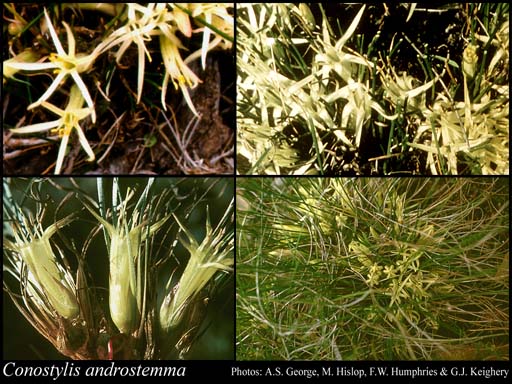- Reference
- Fragm. (Mueller) 8:19 (1873)
- Conservation Code
- Not threatened
- Naturalised Status
- Native to Western Australia
- Name Status
- Current
Rhizomatous, tufted perennial, grass-like or herb, 0.1-0.3 m high. Fl. yellow-cream, May to Aug. Lateritic gravel, yellow sand. Breakaway screes, hilltops.

Scientific Description
Leaves round (leaves terete), 45-270 mm long, 0.8-1 mm wide; bristles or hairs on the leaf margin absent; hairs on the surface of the leaf absent (leaf surfaces glabrous). Scape absent. Inflorescence subtended by a bract 8-10 mm long, with one flower; floral bracts 6-10 mm long; pedicels present, 4-6 mm long; flowers 25-45 mm long. Perianth hairy, radially symmetrical, uniformly coloured, white to cream or yellow, with six more or less equal tepals, the inner segments 15-22 mm long. Stamens six, in one level; filaments 11-12 mm long; anther 3.2-5 mm long, without an appendage. Style 33-45 mm long. Flowers in May, June, July or August. Occurs in the Yalgoo, Geraldton Sandplains, Swan Coastal Plain, Avon Wheatbelt and Jarrah Forest IBRA bioregion(s), of the South-west Botanical Province.
Distribution
- IBRA Regions
- Avon Wheatbelt, Geraldton Sandplains, Jarrah Forest, Swan Coastal Plain, Yalgoo.
- IBRA Subregions
- Dandaragan Plateau, Edel, Geraldton Hills, Katanning, Lesueur Sandplain, Merredin, Northern Jarrah Forest, Perth.
- Local Government Areas (LGAs)
- Carnamah, Chapman Valley, Chittering, Coorow, Dandaragan, Gosnells, Greater Geraldton, Irwin, Kalamunda, Mingenew, Moora, Mundaring, Murray, Northampton, Perenjori, Serpentine-Jarrahdale, Shark Bay, Swan, Three Springs, Toodyay, Victoria Plains, Wanneroo, Wongan-Ballidu.